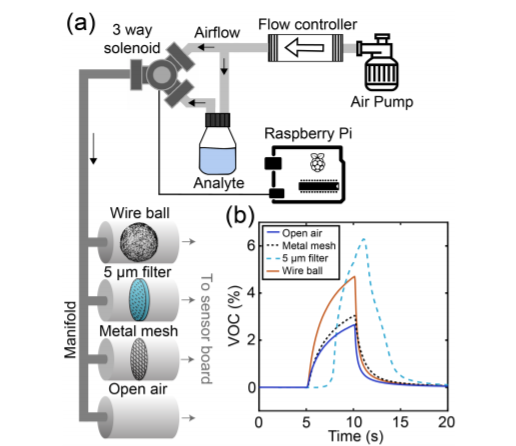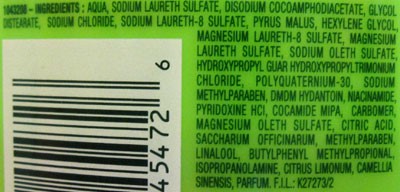
Engineers from Brown University in Rhode Island have invented a small, low-cost sensor device which is able to classify odors using input from a mimicked “sniffing” action. It’s called TruffleBot, and it’s here to raise the bar on electronic “noses”. It also works with Raspberry Pi, an inexpensive mini-computer popular with electronics hobbyists, students, and others in the “maker” crowd.
Generally, an electronic nose is a device comprising several chemical sensors whose results are fed through a pattern-recognition system to identify odors. In traditional devices, the chemical responses alone are used for classification. The engineers behind this invention, however, decided to incorporate non-chemical data to account for the mechanics of the smell process used in nature for a better result. Their experiment proved successful with an approximate 95-98% rate of accuracy in identification compared to about 80-90% accuracy with the chemical sensors alone.
According to the inventors’ published paper, the guiding knowledge that made TruffleBot so useful in odor detection was this: Different smells have different impacts on the air around them, and measuring the variations enables more accurate identification. Did you know that beer odor decreases air pressure and increases temperature? The changes are slight, but TruffleBot can sense them.
This is where the “sniffing” comes in. The device uses air pumped through four obstructed pathways before sending it through chemical and non-chemical sensors. Odors impact the air surrounding them, and the movement of the air through obstacles (“sniffing”) enables the odors’ impact to be more accurately measured.

A chart detailing how TruffleBot processes odors. | Credit: Brown University
So, where exactly would one need an electronic nose? Everywhere. Devices with the chemical sensing ability are being used in agriculture, military, and commercial applications to identify all sorts environmental data. Essentially, electronic noses are useful in any industrial application that has odor involved.
Nasal Marketing
Did you know that it’s possible to trademark a smell in the United States? It’s not easy to accomplish given the somewhat difficult requirements to meet, but a few such things exist. The fact that Play-Doh, a product whose smell is probably one of its most distinct features, was granted a trademark for the scent only this year is testament to the difficulty of obtaining such a mark. However, the fact that some companies have found enough incentive to make sure only their company can give your nose a particular chemical experience tells a lot about that sense’s importance from a marketing perspective.
On one hand, utilizing smell in marketing might seem a little manipulative. After all, creating an air freshener that reminds someone of a beloved, deceased relative on purpose might not seem like a particularly ethical way to target their money. On the other hand (or bigger picture), however, the motivation for marketers to use scent as a tool involves a sort of “chicken or the egg” question.
To summarize part of an article in the journal Sensors on the role scent plays in society and commerce, the aroma of products has a direct impact on their appeal to customers and thus, the success of the product. In fact, a change in a product’s formula that impacts its smell can, and often has had, devastating sales results. In other words, it’s not enough for a company to create a good product; it has to be a good smelling product.
Hacking the Human Nose
It’s probably no surprise that the commercial industry has categorized consumer preferences when it comes to smells. As the first sense fully developed after birth, our noses link us to things like memories, emotions, and chemical communication (think pheromones). Is it any wonder, then, why businesses might be interested in the functionality of the organ that is doing the receiving?
Turns out, there’s an enormous amount of science behind “hacking” a nose. Identifying smells is more than just categorizing chemical mixtures as “floral” or “masculine”. The multitude of chemical combinations available generates such a vast amount of data that scientists have implemented computer neural networks to analyze and classify it. Also, the actual mechanics of smelling something impacts the way the smell is received and processed in the brain. Computers and scientific instruments come in handy there as well. To really get to the core of human response to an aroma, lots of non-human tools are needed, and this is essentially where the TruffleBot fits in the greater realm of “olfactory” science.

I think this is a Sumerian variant for “fruity”. | Credit: AstroJane’s bathroom collection.
More Than Just Your Money
Perhaps one of the most innovative uses found for electronic noses is in disease research. One of the limitations of human smell is its overall weakness. A dog’s sense of smell is around 40 times better than a human’s, and a bear’s is a whopping 2,100 times superior to ours. That said, when researchers learned that certain diseases give off certain odors, the human nose wasn’t exactly the first choice to utilize in sensing them.
An electronic nose makes good use of the simple fact that organic matter releases chemicals into the air. For example, when a plant has been impacted by a fungus, the changes brought on in the plant’s structure release what’s called “volatile organic compounds” (VOCs). These VOCs can be detected by the sensors in an electronic nose and then provide information on the type of disease present without destroying the plants being tested.
Humans have some amazing things to gain from electronic noses, too. Using sensors to process odors from VOCs, things like digestive diseases, kidney diseases, and diabetes, among many others, are all receiving scientific attention for non-invasive diagnosis by these types of devices. With improvements brought on by inventions like TruffleBot, especially combined with its low-cost and resulting accessibility, a future involving remote diagnoses for any number of illnesses and diseases seems more possible every day.

var disqus_shortname = «teslarati»;
var disqus_title = «Engineers develop bio-machine nose that can «sniff» and classify odors»;
var disqus_url = «https://www.teslarati.com/trufflebot-electronic-nose-sniff-smell-odors/»;
var disqus_identifier = «teslarati-86995»;

